Yan Shen
Towards Reliable Forgetting: A Survey on Machine Unlearning Verification, Challenges, and Future Directions
Jun 18, 2025Abstract:With growing demands for privacy protection, security, and legal compliance (e.g., GDPR), machine unlearning has emerged as a critical technique for ensuring the controllability and regulatory alignment of machine learning models. However, a fundamental challenge in this field lies in effectively verifying whether unlearning operations have been successfully and thoroughly executed. Despite a growing body of work on unlearning techniques, verification methodologies remain comparatively underexplored and often fragmented. Existing approaches lack a unified taxonomy and a systematic framework for evaluation. To bridge this gap, this paper presents the first structured survey of machine unlearning verification methods. We propose a taxonomy that organizes current techniques into two principal categories -- behavioral verification and parametric verification -- based on the type of evidence used to assess unlearning fidelity. We examine representative methods within each category, analyze their underlying assumptions, strengths, and limitations, and identify potential vulnerabilities in practical deployment. In closing, we articulate a set of open problems in current verification research, aiming to provide a foundation for developing more robust, efficient, and theoretically grounded unlearning verification mechanisms.
BiAssemble: Learning Collaborative Affordance for Bimanual Geometric Assembly
Jun 06, 2025Abstract:Shape assembly, the process of combining parts into a complete whole, is a crucial robotic skill with broad real-world applications. Among various assembly tasks, geometric assembly--where broken parts are reassembled into their original form (e.g., reconstructing a shattered bowl)--is particularly challenging. This requires the robot to recognize geometric cues for grasping, assembly, and subsequent bimanual collaborative manipulation on varied fragments. In this paper, we exploit the geometric generalization of point-level affordance, learning affordance aware of bimanual collaboration in geometric assembly with long-horizon action sequences. To address the evaluation ambiguity caused by geometry diversity of broken parts, we introduce a real-world benchmark featuring geometric variety and global reproducibility. Extensive experiments demonstrate the superiority of our approach over both previous affordance-based and imitation-based methods. Project page: https://sites.google.com/view/biassembly/.
SR3D: Unleashing Single-view 3D Reconstruction for Transparent and Specular Object Grasping
May 30, 2025Abstract:Recent advancements in 3D robotic manipulation have improved grasping of everyday objects, but transparent and specular materials remain challenging due to depth sensing limitations. While several 3D reconstruction and depth completion approaches address these challenges, they suffer from setup complexity or limited observation information utilization. To address this, leveraging the power of single view 3D object reconstruction approaches, we propose a training free framework SR3D that enables robotic grasping of transparent and specular objects from a single view observation. Specifically, given single view RGB and depth images, SR3D first uses the external visual models to generate 3D reconstructed object mesh based on RGB image. Then, the key idea is to determine the 3D object's pose and scale to accurately localize the reconstructed object back into its original depth corrupted 3D scene. Therefore, we propose view matching and keypoint matching mechanisms,which leverage both the 2D and 3D's inherent semantic and geometric information in the observation to determine the object's 3D state within the scene, thereby reconstructing an accurate 3D depth map for effective grasp detection. Experiments in both simulation and real world show the reconstruction effectiveness of SR3D.
CrayonRobo: Object-Centric Prompt-Driven Vision-Language-Action Model for Robotic Manipulation
May 04, 2025Abstract:In robotic, task goals can be conveyed through various modalities, such as language, goal images, and goal videos. However, natural language can be ambiguous, while images or videos may offer overly detailed specifications. To tackle these challenges, we introduce CrayonRobo that leverages comprehensive multi-modal prompts that explicitly convey both low-level actions and high-level planning in a simple manner. Specifically, for each key-frame in the task sequence, our method allows for manual or automatic generation of simple and expressive 2D visual prompts overlaid on RGB images. These prompts represent the required task goals, such as the end-effector pose and the desired movement direction after contact. We develop a training strategy that enables the model to interpret these visual-language prompts and predict the corresponding contact poses and movement directions in SE(3) space. Furthermore, by sequentially executing all key-frame steps, the model can complete long-horizon tasks. This approach not only helps the model explicitly understand the task objectives but also enhances its robustness on unseen tasks by providing easily interpretable prompts. We evaluate our method in both simulated and real-world environments, demonstrating its robust manipulation capabilities.
Using Powerful Prior Knowledge of Diffusion Model in Deep Unfolding Networks for Image Compressive Sensing
Mar 11, 2025Abstract:Recently, Deep Unfolding Networks (DUNs) have achieved impressive reconstruction quality in the field of image Compressive Sensing (CS) by unfolding iterative optimization algorithms into neural networks. The reconstruction quality of DUNs depends on the learned prior knowledge, so introducing stronger prior knowledge can further improve reconstruction quality. On the other hand, pre-trained diffusion models contain powerful prior knowledge and have a solid theoretical foundation and strong scalability, but it requires a large number of iterative steps to achieve reconstruction. In this paper, we propose to use the powerful prior knowledge of pre-trained diffusion model in DUNs to achieve high-quality reconstruction with less steps for image CS. Specifically, we first design an iterative optimization algorithm named Diffusion Message Passing (DMP), which embeds a pre-trained diffusion model into each iteration process of DMP. Then, we deeply unfold the DMP algorithm into a neural network named DMP-DUN. The proposed DMP-DUN can use lightweight neural networks to achieve mapping from measurement data to the intermediate steps of the reverse diffusion process and directly approximate the divergence of the diffusion model, thereby further improving reconstruction efficiency. Extensive experiments show that our proposed DMP-DUN achieves state-of-the-art performance and requires at least only 2 steps to reconstruct the image. Codes are available at https://github.com/FengodChen/DMP-DUN-CVPR2025.
GarmentLab: A Unified Simulation and Benchmark for Garment Manipulation
Nov 02, 2024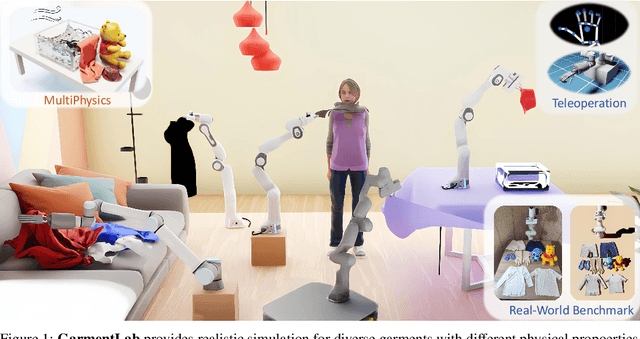

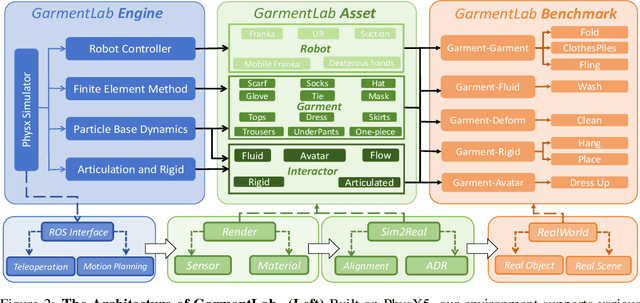

Abstract:Manipulating garments and fabrics has long been a critical endeavor in the development of home-assistant robots. However, due to complex dynamics and topological structures, garment manipulations pose significant challenges. Recent successes in reinforcement learning and vision-based methods offer promising avenues for learning garment manipulation. Nevertheless, these approaches are severely constrained by current benchmarks, which offer limited diversity of tasks and unrealistic simulation behavior. Therefore, we present GarmentLab, a content-rich benchmark and realistic simulation designed for deformable object and garment manipulation. Our benchmark encompasses a diverse range of garment types, robotic systems and manipulators. The abundant tasks in the benchmark further explores of the interactions between garments, deformable objects, rigid bodies, fluids, and human body. Moreover, by incorporating multiple simulation methods such as FEM and PBD, along with our proposed sim-to-real algorithms and real-world benchmark, we aim to significantly narrow the sim-to-real gap. We evaluate state-of-the-art vision methods, reinforcement learning, and imitation learning approaches on these tasks, highlighting the challenges faced by current algorithms, notably their limited generalization capabilities. Our proposed open-source environments and comprehensive analysis show promising boost to future research in garment manipulation by unlocking the full potential of these methods. We guarantee that we will open-source our code as soon as possible. You can watch the videos in supplementary files to learn more about the details of our work. Our project page is available at: https://garmentlab.github.io/
Broadcasting Support Relations Recursively from Local Dynamics for Object Retrieval in Clutters
Jun 04, 2024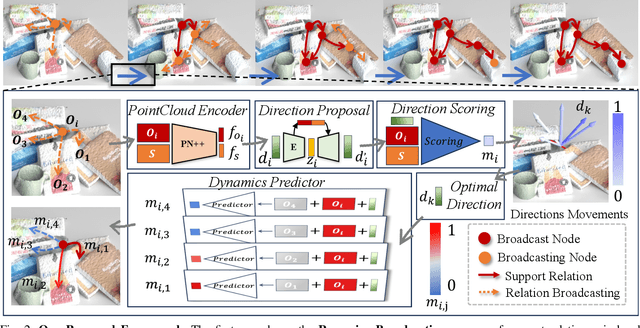
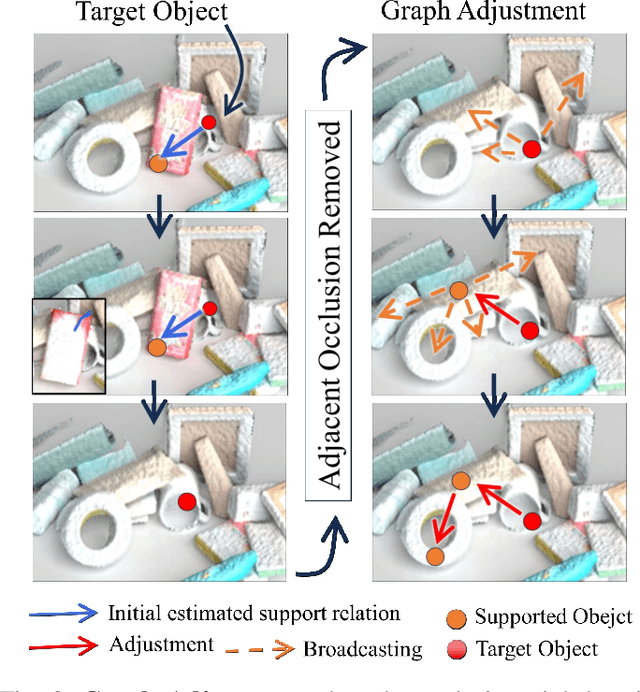
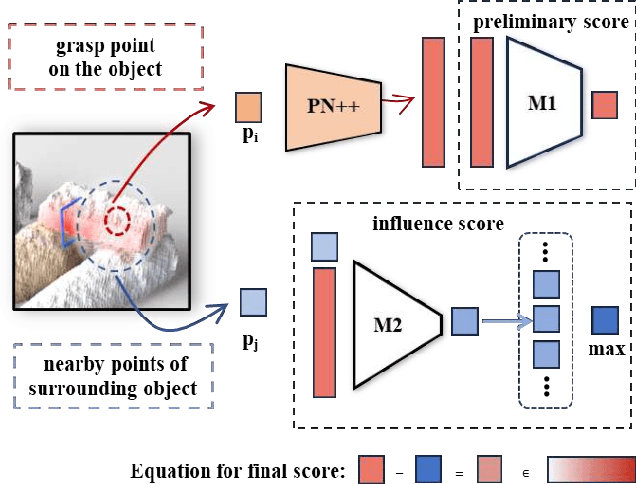
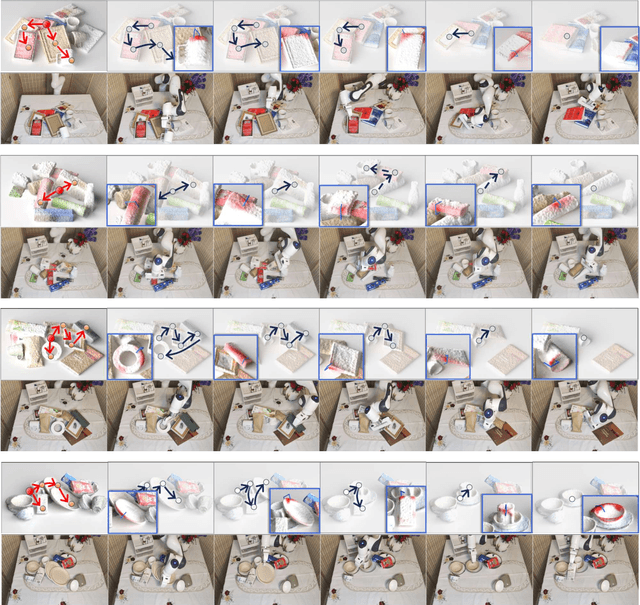
Abstract:In our daily life, cluttered objects are everywhere, from scattered stationery and books cluttering the table to bowls and plates filling the kitchen sink. Retrieving a target object from clutters is an essential while challenging skill for robots, for the difficulty of safely manipulating an object without disturbing others, which requires the robot to plan a manipulation sequence and first move away a few other objects supported by the target object step by step. However, due to the diversity of object configurations (e.g., categories, geometries, locations and poses) and their combinations in clutters, it is difficult for a robot to accurately infer the support relations between objects faraway with various objects in between. In this paper, we study retrieving objects in complicated clutters via a novel method of recursively broadcasting the accurate local dynamics to build a support relation graph of the whole scene, which largely reduces the complexity of the support relation inference and improves the accuracy. Experiments in both simulation and the real world demonstrate the efficiency and effectiveness of our method.
NaturalVLM: Leveraging Fine-grained Natural Language for Affordance-Guided Visual Manipulation
Mar 13, 2024Abstract:Enabling home-assistant robots to perceive and manipulate a diverse range of 3D objects based on human language instructions is a pivotal challenge. Prior research has predominantly focused on simplistic and task-oriented instructions, i.e., "Slide the top drawer open". However, many real-world tasks demand intricate multi-step reasoning, and without human instructions, these will become extremely difficult for robot manipulation. To address these challenges, we introduce a comprehensive benchmark, NrVLM, comprising 15 distinct manipulation tasks, containing over 4500 episodes meticulously annotated with fine-grained language instructions. We split the long-term task process into several steps, with each step having a natural language instruction. Moreover, we propose a novel learning framework that completes the manipulation task step-by-step according to the fine-grained instructions. Specifically, we first identify the instruction to execute, taking into account visual observations and the end-effector's current state. Subsequently, our approach facilitates explicit learning through action-prompts and perception-prompts to promote manipulation-aware cross-modality alignment. Leveraging both visual observations and linguistic guidance, our model outputs a sequence of actionable predictions for manipulation, including contact points and end-effector poses. We evaluate our method and baselines using the proposed benchmark NrVLM. The experimental results demonstrate the effectiveness of our approach. For additional details, please refer to https://sites.google.com/view/naturalvlm.
Continual Domain Adversarial Adaptation via Double-Head Discriminators
Feb 05, 2024Abstract:Domain adversarial adaptation in a continual setting poses a significant challenge due to the limitations on accessing previous source domain data. Despite extensive research in continual learning, the task of adversarial adaptation cannot be effectively accomplished using only a small number of stored source domain data, which is a standard setting in memory replay approaches. This limitation arises from the erroneous empirical estimation of $\gH$-divergence with few source domain samples. To tackle this problem, we propose a double-head discriminator algorithm, by introducing an addition source-only domain discriminator that are trained solely on source learning phase. We prove that with the introduction of a pre-trained source-only domain discriminator, the empirical estimation error of $\gH$-divergence related adversarial loss is reduced from the source domain side. Further experiments on existing domain adaptation benchmark show that our proposed algorithm achieves more than 2$\%$ improvement on all categories of target domain adaptation task while significantly mitigating the forgetting on source domain.
ManipLLM: Embodied Multimodal Large Language Model for Object-Centric Robotic Manipulation
Dec 24, 2023



Abstract:Robot manipulation relies on accurately predicting contact points and end-effector directions to ensure successful operation. However, learning-based robot manipulation, trained on a limited category within a simulator, often struggles to achieve generalizability, especially when confronted with extensive categories. Therefore, we introduce an innovative approach for robot manipulation that leverages the robust reasoning capabilities of Multimodal Large Language Models (MLLMs) to enhance the stability and generalization of manipulation. By fine-tuning the injected adapters, we preserve the inherent common sense and reasoning ability of the MLLMs while equipping them with the ability for manipulation. The fundamental insight lies in the introduced fine-tuning paradigm, encompassing object category understanding, affordance prior reasoning, and object-centric pose prediction to stimulate the reasoning ability of MLLM in manipulation. During inference, our approach utilizes an RGB image and text prompt to predict the end effector's pose in chain of thoughts. After the initial contact is established, an active impedance adaptation policy is introduced to plan the upcoming waypoints in a closed-loop manner. Moreover, in real world, we design a test-time adaptation (TTA) strategy for manipulation to enable the model better adapt to the current real-world scene configuration. Experiments in simulator and real-world show the promising performance of ManipLLM. More details and demonstrations can be found at https://sites.google.com/view/manipllm.
 Add to Chrome
Add to Chrome Add to Firefox
Add to Firefox Add to Edge
Add to Edge